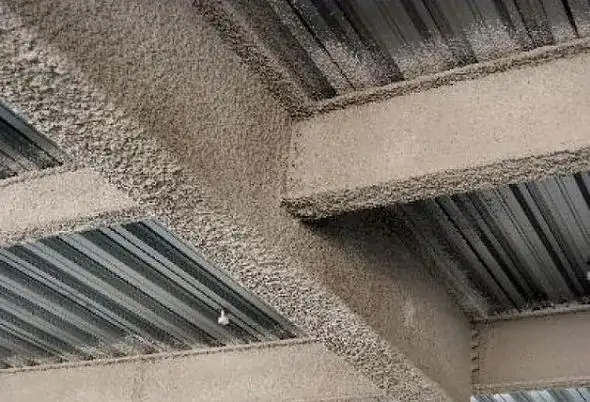Our Services

Fire Protection Coating
Intumescent coatings are a type of fire-resistant coating that undergoes a chemical reaction when exposed to heat or fire, expanding in volume to form a protective char layer. This expanded char layer acts as an insulating barrier, slowing down the transfer of heat to the underlying substrate and delaying the spread of fire. Intumescent coatings are widely used in building construction, particularly in passive fire protection systems, to enhance the fire resistance of structural elements such as steel beams, columns, and walls. Here’s a more detailed description of intumescent coatings:
Composition:
Intumescent coatings typically consist of several key components, including:- Binder: The binder holds the coating together and adheres it to the substrate. Common binder materials include acrylics, epoxy resins, and polyurethanes.
- Pigments: Specialized pigments, such as ammonium polyphosphate and expandable graphite, are incorporated into the coating formulation to facilitate the intumescent reaction.
- Fillers: Fillers may be added to enhance properties such as durability, texture, or color.
- Additives: Additives such as stabilizers, surfactants, and flame retardants may be included to improve performance and application characteristics.
Application:
Intumescent coatings are typically applied to structural steel and other substrates using spray equipment or by brush or roller. The coating is usually applied in multiple layers to achieve the desired thickness and fire resistance rating. It’s essential to follow the manufacturer’s application instructions carefully to ensure proper coverage and performance.Intumescent Reaction:
When exposed to fire or high temperatures, the intumescent coating undergoes a chemical reaction known as intumescence. During this reaction, the coating expands rapidly, forming a thick, insulating char layer. This char layer acts as a thermal barrier, insulating the substrate from the heat of the fire and preventing structural failure.Fire Protection Performance:
Intumescent coatings provide effective passive fire protection by significantly delaying the onset of structural failure and reducing the spread of fire. The thickness of the intumescent coating and the specific formulation used determine the fire resistance rating of the coated assembly. Intumescent coatings are commonly tested and rated according to standards such as ASTM E119 or UL 263 to ensure compliance with building and fire codes.Applications :
Intumescent coatings are used in a wide range of applications where fire resistance is required, including:- Commercial Buildings: Protecting structural steel components such as beams, columns, and decking.
- Industrial Facilities: Fireproofing steel structures in petrochemical plants, refineries, power plants, and other industrial facilities.
- Transportation Infrastructure: Fireproofing steel bridges, tunnels, and rail structures.
- Residential Construction: Enhancing the fire resistance of steel framing systems and other structural elements in residential buildings.
Maintenance:
While intumescent coatings provide durable fire protection, periodic inspections and maintenance are essential to ensure continued effectiveness. Inspections should check for damage, adhesion loss, or deterioration of the coating, and any necessary repairs or recoating should be performed promptly.
Overall, intumescent coatings play a crucial role in passive fire protection strategies, helping to minimize the spread of fire and protect lives and property in the event of a fire emergency.

Cementitious Coatings
Cementitious coatings are a type of protective coating composed primarily of cement-based materials. These coatings are commonly used for waterproofing, surface protection, and aesthetic enhancement in a variety of construction and industrial applications. Here’s a more detailed description of cementitious coatings:
-
Composition:
Cementitious coatings typically consist of a blend of cement, aggregates, additives, and water. The exact composition may vary depending on the specific formulation and intended application. Some coatings may also incorporate additional components such as polymers or fibers to enhance performance characteristics. -
Application:
Cementitious coatings are applied to surfaces using various methods, including brushing, spraying, or troweling. The application technique depends on factors such as the substrate type, surface condition, and desired thickness of the coating. These coatings can be applied to a wide range of substrates, including concrete, masonry, metal, wood, and some plastics. -
Properties :
Cementitious coatings offer several beneficial properties, including:- Waterproofing Cementitious coatings form a dense, impermeable barrier that effectively protects underlying surfaces from water penetration and moisture damage.
- Durability: When properly applied and maintained, cementitious coatings can provide long-lasting protection against environmental factors such as weathering, UV exposure, and chemical exposure.
- Adhesion: Cementitious coatings adhere well to most substrates, ensuring reliable bonding and effective protection.
- Fire Resistance : Cementitious coatings exhibit inherent fire-resistant properties, making them suitable for applications where fire protection is a concern.
- Breathability : Some cementitious coatings allow for moisture vapor transmission, which can help prevent the buildup of moisture within substrates and reduce the risk of damage due to trapped moisture.
-
Applications:
Cementitious coatings find widespread use in various industries and applications, including:- Building Construction : Waterproofing basements, roofs, and other structural elements; protecting concrete and masonry surfaces from corrosion and degradation.
- Infrastructure Projects: Coating bridges, tunnels, dams, and other infrastructure elements to enhance durability and longevity.
- Industrial Facilities: Providing chemical-resistant coatings for floors, walls, and tanks in industrial settings.
- Decorative Finishes: Creating decorative finishes on interior and exterior surfaces, including textured coatings and faux finishes.
-
Maintenance:
Proper maintenance is essential to ensure the continued effectiveness and longevity of cementitious coatings. Regular inspections, cleaning, and occasional recoating may be necessary to address wear and tear, surface damage, or changes in environmental conditions.
Overall, cementitious coatings offer a versatile and effective solution for protecting and enhancing a wide range of surfaces in various construction and industrial applications.
Passive Fire System
Passive Fire Protection (PFP) is a critical component of building safety designed to contain and mitigate the spread of fire, ensuring the protection of life, property, and assets. Unlike active fire protection systems that require human intervention or external energy sources to operate, passive fire protection elements are inherently built into the structure, providing a reliable and automatic defines mechanism.
Key Components of Passive Fire Protection Systems:
Fire-Rated Materials: PFP systems incorporate fire-resistant materials in construction elements such as walls, floors, and ceilings. These materials are engineered to withstand high temperatures and prevent the rapid spread of flames.
Compartmentation: Buildings are divided into compartments, each with its own fire-resistant boundaries. This strategy restricts the movement of fire and smoke, confining it to a specific area and preventing it from engulfing the entire structure.
Fire Doors and Fire Windows: These specialized doors and windows are constructed with fire-resistant materials and self-closing mechanisms. They act as barriers, hindering the progression of fire and smoke between different compartments.
Fire Dampers: Integrated into ventilation and duct systems, fire dampers automatically close in the event of a fire, preventing the spread of smoke and flames through ductwork.
Firestopping and Penetration Seals: These elements seal openings in walls and floors created for utility services, preventing fire and smoke from spreading through gaps and penetrations.
Importance of Passive Fire Protection Systems:
Life Safety: PFP systems are fundamental in providing occupants with sufficient time to evacuate a building safely during a fire incident.
Property Protection: By containing and minimising the impact of a fire within a localised area, PFP systems help protect valuable assets and reduce property damage.
Business Continuity: Implementing effective passive fire protection contributes to minimising downtime and promoting business continuity by limiting the extent of fire-related disruptions.
Regulatory Compliance: Adhering to local building codes and regulations, which often mandate the inclusion of passive fire protection measures, is crucial for legal compliance and ensuring the safety of building occupants.
Protective Coatings & Blasting
Protective coatings and blasting are integral processes in surface preparation and preservation, commonly used in industrial, marine, and commercial sectors to protect substrates from corrosion, wear, and environmental damage. Here’s a detailed description of each:
Protective Coatings:
Protective coatings refer to a wide range of materials applied to surfaces to provide a protective barrier against corrosion, abrasion, chemical exposure, and other environmental factors. These coatings can be classified into various types based on their composition, application method, and intended use. Some common types of protective coatings include:
- Paints: Traditional paints, including epoxy, polyurethane, acrylic, and alkyd paints, are widely used for general-purpose protection against corrosion and weathering. These coatings offer a combination of aesthetic appeal and durability.
- Industrial Coatings: Industrial coatings are specifically formulated to withstand harsh environments and provide long-term protection for industrial equipment, machinery, pipelines, and structures. They often contain additives such as corrosion inhibitors, abrasion resistance enhancers, and UV stabilizers.
- High-Performance Coatings: High-performance coatings are designed for extreme conditions, such as high temperatures, chemical exposure, or immersion in corrosive fluids. Examples include ceramic coatings, fluoropolymer coatings, and thermal spray coatings.
- Intumescent Coatings: As mentioned earlier, intumescent coatings are specialized fire-resistant coatings that expand when exposed to heat, forming an insulating char layer that protects the substrate from fire damage.
- Marine Coatings: Marine coatings are formulated to protect ships, offshore platforms, docks, and other marine structures from corrosion, fouling, and environmental degradation. They may include anti-corrosive primers, antifouling paints, and protective topcoats.
Blasting:
Blasting is a surface preparation technique used to remove contaminants, rust, old coatings, and surface irregularities from substrates before applying protective coatings. It involves propelling abrasive media at high velocity onto the surface to achieve the desired level of cleanliness and profile. Common blasting methods include:
- Abrasive Blasting: Abrasive blasting, also known as sandblasting, involves propelling abrasive materials such as sand, garnet, steel grit, or aluminum oxide onto the surface using compressed air or centrifugal force. This method effectively removes rust, scale, old paint, and other surface contaminants.
- Shot Blasting: Shot blasting uses spherical metallic shot to clean and profile surfaces. The shot is propelled at the surface using centrifugal force, impacting the surface and dislodging contaminants and coatings. Shot blasting is often used for large-scale projects and concrete surface preparation.
- Grit Blasting: Grit blasting is similar to abrasive blasting but uses larger and more angular abrasive particles, such as steel grit or crushed glass, to achieve a more aggressive surface profile. Grit blasting is suitable for removing heavy corrosion and scale from metal surfaces.
- Water Blasting: Water blasting, or hydroblasting, uses high-pressure water jets to remove surface contaminants and coatings. It is an environmentally friendly alternative to abrasive blasting and is commonly used for cleaning delicate surfaces or removing coatings from sensitive substrates.
In summary, protective coatings and blasting play critical roles in surface preparation, maintenance, and corrosion protection across various industries. By selecting the appropriate coatings and surface preparation methods, operators can ensure the long-term integrity and durability of substrates exposed to harsh environmental conditions.

